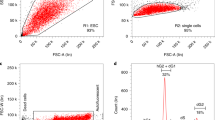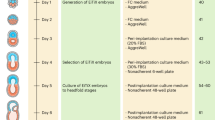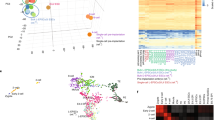Abstract
The production of mouse chimeras is a common step in the establishment of genetically modified animal strains. Chimeras also provide a powerful experimental tool for following cell behavior during both prenatal and postnatal development. This protocol outlines a simple and economical technique for the production of large numbers of mouse chimeras using traditional diploid morula↔diploid embryonic stem (ES) cell aggregations. Additional steps are included to describe the procedures necessary to produce specialized tetraploid chimeras using tetraploid morula↔diploid ES cell aggregations. This increasingly popular form of chimera produces embryos of nearly complete ES cell derivation that can be used to speed transgenic production or ask developmental questions. Using this protocol, mouse chimeras can be generated and transferred to pseudopregnant surrogate mothers in a 5-d period.
This is a preview of subscription content, access via your institution
Access options
Subscribe to this journal
Receive 12 print issues and online access
$259.00 per year
only $21.58 per issue
Buy this article
- Purchase on Springer Link
- Instant access to full article PDF
Prices may be subject to local taxes which are calculated during checkout




Similar content being viewed by others
References
Bradley, A., Evans, M., Kaufman, M.H. & Robertson, E. Formation of germ-line chimeras from embryo-derived teratocarcinoma cell lines. Nature 309, 255–256 (1984).
Thompson, S., Clarke, A.R., Pow, A.M., Hooper, M.L. & Melton, D.W. Germ line transmission and expression of a corrected HPRT gene produced by gene targeting in embryonic stem cells. Cell 56, 313–321 (1989).
Tam, P.P. & Rossant, J. Mouse embryonic chimeras: tools for studying mammalian development. Development 130, 6155–6163 (2003).
Kunath, T. et al. Imprinted X-inactivation in extra-embryonic endoderm cell lines from mouse blastocysts. Development 132, 1649–1661 (2005).
Tanaka, S., Kunath, T., Hadjantonakis, A.K., Nagy, A. & Rossant, J. Promotion of trophoblast stem cell proliferation by FGF4. Science 282, 2072–2075 (1998).
Nagy, A., Gertsenstein, M., Vinterstein, K. & Behringer, R.R. Manipulating the mouse embryo: a laboratory manual (Cold Spring Harbor Laboratory Press, Cold Spring Harbor, New York, 2003).
Papaioannou, V.E. & Behringer, R.R. Mouse Phenotypes: A handbook of mutation analysis (Cold Spring Harbor Laboratory Press, Cold Spring Harbor, New York, 2005).
Wakayama, T. et al. Differentiation of embryonic stem cell lines generated from adult somatic cells by nuclear transfer. Science 292, 740–743 (2001).
Wood, S.A. et al. Simple and efficient production of embryonic stem cell-embryo chimeras by coculture. Proc. Natl. Acad. Sci. USA 90, 4582–4585 (1993).
Papaioannou, V. & Johnson, R. Production of chimeras by blastocyst and morula injection of targeted ES cells. in Gene Targeting: A Practical Approach 2nd edn. (ed. Joyner, A.L.) 133–175 (Oxford Univ. Press, Oxford, 2000).
Nagy, A. & Rossant, J. Production and analysis of ES cell aggregation chimeras. in Gene Targeting: A Practical Approach 2nd edn. (ed. Joyner, A.L.) 177–206 (Oxford Univ. Press, Oxford, 2000).
Nagy, A., Rossant, J., Nagy, R., Abramow-Newerly, W. & Roder, J.C. Derivation of completely cell culture-derived mice from early-passage embryonic stem cells. Proc. Natl. Acad. Sci. USA 90, 8424–8428 (1993).
Li, X. et al. The genetic heterozygosity and fitness of tetraploid embryos and embryonic stem cells are crucial parameters influencing survival of mice derived from embryonic stem cells by tetraploid embryo aggregation. Reproduction 130, 53–59 (2005).
Eggan, K. et al. Hybrid vigor, fetal overgrowth, and viability of mice derived by nuclear cloning and tetraploid embryo complementation. Proc. Natl. Acad. Sci. USA 98, 6209–6214 (2001).
Beddington, R.S. & Robertson, E.J. An assessment of the developmental potential of embryonic stem cells in the midgestation mouse embryo. Development 105, 733–737 (1989).
Nagy, A. et al. Embryonic stem cells alone are able to support fetal development in the mouse. Development 110, 815–821 (1990).
Eakin, G.S. & Behringer, R.R. Tetraploid development in the mouse. Dev. Dyn. 228, 751–766 (2003).
Eakin, G.S., Hadjantonakis, A.K., Papaioannou, V.E. & Behringer, R.R. Developmental potential and behavior of tetraploid cells in the mouse embryo. Dev. Biol. 288, 150–159 (2005).
Mackay, G.E. & West, J.D. Fate of tetraploid cells in 4n↔2n chimeric mouse blastocysts. Mech. Dev. 122, 1266–1281 (2005).
Iwasaki, S., Campbell, K.H., Galli, C. & Akiyama, K. Production of live calves derived from embryonic stem-like cells aggregated with tetraploid embryos. Biol. Reprod. 62, 470–475 (2000).
Tarkowski, A.K., Witkowska, A. & Opas, J. Development of cytochalasin in B-induced tetraploid and diploid/tetraploid mosaic mouse embryos. J. Embryol. Exp. Morphol. 41, 47–64 (1977).
Ueda, O., Jishage, K., Kamada, N., Uchida, S. & Suzuki, H. Production of mice entirely derived from embryonic stem (ES) cell with many passages by coculture of ES cells with cytochalasin B induced tetraploid embryos. Exp. Anim. 44, 205–210 (1995).
Kubiak, J.Z. & Tarkowski, A.K. Electrofusion of mouse blastomeres. Exp. Cell Res. 157, 561–566 (1985).
McLaughlin, K.J. Production of tetraploid embryos by electrofusion. Methods Enzymol. 225, 919–930 (1993).
Mintz, B. Allophenic mice of mutiple embryo origin. in Methods in Mammalian Embryology (ed. Daniel, J.C. Jr.) 186–214 (W.H. Freeman and Company, San Francisco, 1971).
Kishigami, S. et al. Production of cloned mice by somatic cell nuclear transfer. Nat. Protocols 1, 125–138 (2006).
Singer, O., Tiscornia, G., Ikawa, M. & Verma, I.M. Rapid generation of knockdown transgenic mice by silencing lentiviral vectors. Nat. Protocols 1, 1–7 (2006).
Ware, L.M. & Axelrad, A.A. Inherited resistance to N- and B-tropic murine leukemia viruses in vitro: evidence that congenic mouse strains SIM and SIM.R differ at the Fv-1 locus. Virology 50, 339–348 (1972).
Evans, M.J. & Kaufman, M.H. Establishment in culture of pluripotential cells from mouse embryos. Nature 292, 154–156 (1981).
Hadjantonakis, A.K., Gertsenstein, M., Ikawa, M., Okabe, M. & Nagy, A. Generating green fluorescent mice by germline transmission of green fluorescent ES cells. Mech. Dev. 76, 79–90 (1998).
Mullen, R.J. & Whitten, W.K. Relationship of genotype and degree of chimerism in coat color to sex ratios and gametogenesis in chimeric mice. J. Exp. Zool. 178, 165–176 (1971).
Eggan, K. & Jaenisch, R. Differentiation of F1 embryonic stem cells into viable male and female mice by tetraploid embryo complementation. Methods Enzymol. 365, 25–39 (2003).
Eggan, K. et al. Male and female mice derived from the same embryonic stem cell clone by tetraploid embryo complementation. Nat. Biotechnol. 20, 455–459 (2002).
Schwenk, F. et al. Hybrid embryonic stem cell-derived tetraploid mice show apparently normal morphological, physiological, and neurological characteristics. Mol. Cell. Biol. 23, 3982–3989 (2003).
Hadjantonakis, A.K., Dickinson, M.E., Fraser, S.E. & Papaioannou, V.E. Technicolour transgenics: imaging tools for functional genomics in the mouse. Nat. Rev. Genet. 4, 613–625 (2003).
Nijs, M., Camus, M. & Van Steirteghem, A.C. Evaluation of different biopsy methods of blastomeres from 2-cell mouse embryos. Hum. Reprod. 3, 999–1003 (1988).
Hartshorn, C., Rice, J.E. & Wangh, L.J. Differential pattern of Xist RNA accumulation in single blastomeres isolated from 8-cell stage mouse embryos following laser zona drilling. Mol. Reprod. Dev. 64, 41–51 (2003).
Wang, Z. & Jaenisch, R. At most three ES cells contribute to the somatic lineages of chimeric mice and of mice produced by ES-tetraploid complementation. Dev. Biol. 275, 192–201 (2004).
James, R.M., Kaufman, M.H., Webb, S. & West, J.D. Electrofusion of mouse embryos results in uniform tetraploidy and not tetraploid/diploid mosaicism. Genet. Res. 60, 185–194 (1992).
Bronson, R.A. & McLaren, A. Transfer to the mouse oviduct of eggs with and without the zona pellucida. J. Reprod. Fertil. 22, 129–137 (1970).
Acknowledgements
We thank R.R. Behringer, E.H. Lacy and V.E. Papaioannou for advice, discussions and support.
Author information
Authors and Affiliations
Corresponding author
Ethics declarations
Competing interests
The authors declare no competing financial interests.
Supplementary information
Supplementary Video 1
Time-lapse movie showing induction of tetraploidy by electrofusion. (MOV 1057 kb)
Rights and permissions
About this article
Cite this article
Eakin, G., Hadjantonakis, AK. Production of chimeras by aggregation of embryonic stem cells with diploid or tetraploid mouse embryos. Nat Protoc 1, 1145–1153 (2006). https://doi.org/10.1038/nprot.2006.173
Published:
Issue Date:
DOI: https://doi.org/10.1038/nprot.2006.173
This article is cited by
-
Suppression of apoptosis impairs phalangeal joint formation in the pathogenesis of brachydactyly type A1
Nature Communications (2024)
-
Implantation initiation of self-assembled embryo-like structures generated using three types of mouse blastocyst-derived stem cells
Nature Communications (2019)
-
The interplay of epigenetic marks during stem cell differentiation and development
Nature Reviews Genetics (2017)
-
Pluripotent stem cells and livestock genetic engineering
Transgenic Research (2016)
-
A novel mouse model for Down syndrome that harbor a single copy of human artificial chromosome (HAC) carrying a limited number of genes from human chromosome 21
Transgenic Research (2014)
Comments
By submitting a comment you agree to abide by our Terms and Community Guidelines. If you find something abusive or that does not comply with our terms or guidelines please flag it as inappropriate.



